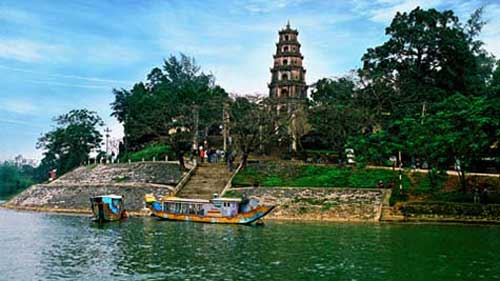
Hue's imperial citadel attracts tourists because of its royal relics and beauty. Hue is also famous for more than 100 pagodas, many of them built in the 17th century such as Linh Mu pagoda, which was built in 1601, Bao Quoc pagoda in 1674 and Tu Dam pagoda in 1683.
Hue’s imperial citadel attracts tourists because of its royal relics and beauty. Hue is also famous for more than 100 pagodas, many of them built in the 17th century such as Linh Mu pagoda, which was built in 1601, Bao Quoc pagoda in 1674 and Tu Dam pagoda in 1683.

Thien Mu Pagoda.
The architecture of Hue’s pagodas are simple but elegant. They are often surrounded by green trees.
Hue pagodas, their designs and decorations reflect the soul of Hue’s people. In addition to the royal citadel and royal relics, pagodas in Hue have become popular destinations for visitors.
Freelance photographer Nguyen Thanh Cong said, “Visitors to Hue often visit the famous Thien Mu and Tu Dam pagodas which are big and associated with Hue’s history. But, I prefer the small and peaceful pagodas”.
Tu Dam pagoda in Truong An ward was built in the late 17th century. The pagoda is comprised of three main rooms, two wings, a bell and drum tower.
In the middle of the garden, there is a statue of anchorite Tam Minh who made great contributions to the pagoda and to the enlightenment and development of Buddhism in central Vietnam. The main worship hall, which is dedicated to Sakyamuni, is simply but solemnly decorated.
Though the architecture of the pagoda is not intact like other pagodas in the north, few know that the pagoda was the venue where the anti-US and anti-Sai Gon puppet regime movements of Buddhist monks and nuns were launched.
Mai Thanh Huong, a tourist from Hanoi, says the strong development of Buddhism resulted in the large number of pagodas and temples and that if you want to learn more about the Buddhist spirit, you should visit Tu Dam.
“Life here is peaceful. People are hospitable. Visiting the pagoda, I gain peace in my mind,” Huong shared.
The small Tu Dam archives the development of Buddhist uprising movements. Tu Hieu pagoda in Thuy Xuan ward is one of Hue’s biggest pagodas and a historical and cultural relic. In the complex, there are pagodas dedicated to eunuchs and Admiral Le Van Duyet.
Photographer Thanh Cong noted, “Tu Hieu is a famous pagoda. This was a place where eunuchs lived out the last days in their lives after leaving the royal court. Nowadays, young monks come here to practice Buddhism and meditation. Unlike monks in other pagodas, who are often quiet, monks in Tu Hieu pagoda are young and play sports”.
Tu Hieu pagoda has three main rooms and two wing rooms. The one in the front is the Buddhist place of worship and the room in the back is dedicated to ancestors. In front of the pagoda, there is a 3-storey tower which was built in 1896.
The tower serves as an archive of royal decrees and proclamations. Located in a beautiful and peaceful spot, not far from Hue city, the pagoda has become a destination for Hue’s people during vacations. Tu Hieu pagoda is Hue’s most popular destination for local and foreign tourists.
Ms Tuyet Mai, a tourist from Ho Chi Minh City, stressed, "For elderly people like me, this is the place to find peace in our minds and to mediate and leave behind daily disturbances, family or social problems. We feel relaxed here”.
Hue’s pagodas are beautiful because their architecture combines both royal and folk styles and because of their imposing landscapes. They are not only places of worship but also destinations for exploration.
(Source:VOV)





